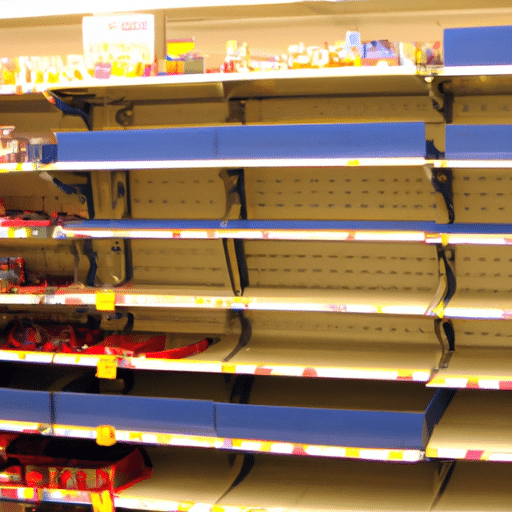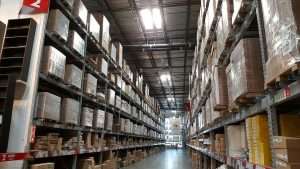How to Prevent and Manage Stockouts in Your Business

In the fast-paced world of business, inventory management plays a crucial role in maintaining a successful operation. This article will provide you with valuable insights on how to prevent and manage stockouts in your business. Join us as we explore the world of inventory management and discover the key steps to maintaining a steady supply chain in your business. How to prevent and manage stockouts in your business.
Understanding Stockouts
One of the challenges that businesses often face is the occurrence of stockouts, which can have a detrimental impact on the overall efficiency and profitability. Stockouts refer to the situation when a business runs out of inventory or stock of a particular product. This means that the product is temporarily unavailable for customers to purchase.
Stockouts can occur for various reasons, such as inaccurate demand forecasting, inefficient inventory management, and poor supplier relationships. It is crucial for businesses to understand the definition and consequences of stockouts in order to effectively prevent and manage them. By understanding the causes of stockouts and implementing effective strategies, you can ensure that your shelves are always well-stocked and your customers are satisfied.
Consequences of Stockouts
Stockouts can have significant consequences for businesses. Firstly, they can result in lost sales and revenue. When customers are unable to find the desired product in stock, they may turn to competitors or postpone their purchase altogether.
This not only leads to immediate losses but also potential long-term damage to customer loyalty and brand reputation. Stockouts can also lead to missed opportunities. If a business consistently experiences stockouts, it may lose potential customers who were seeking the product at that particular time.
Additionally, stockouts can disrupt the supply chain and lead to delays in fulfilling customer orders, causing dissatisfaction and potentially damaging business relationships. Furthermore, stockouts can impact the overall efficiency and profitability of a business. When inventory is not managed effectively, it can result in increased carrying costs and storage expenses. A business may also experience increased costs due to expedited shipping or rush orders to replenish inventory after a stockout.
Overall, the consequences of stockouts include lost sales and revenue, missed opportunities, disruptions in the supply chain, decreased efficiency, and increased costs. It is crucial for businesses to identify the causes of stockouts and implement appropriate prevention and management strategies.
Identifying the Causes of Stockouts
To effectively prevent and manage stockouts, businesses need to identify the underlying causes. Three common causes of stockouts include inaccurate demand forecasting, inefficient inventory management, and poor supplier relationships.
Inaccurate Demand Forecasting
Inaccurate demand forecasting is a major cause of stockouts. Businesses rely on demand forecasts to determine the quantity of products they need to order or produce. If the demand forecast is too low, there is a risk of running out of stock. On the other hand, if the forecast is too high, excess inventory may accumulate, leading to additional costs and potential waste.
To improve demand forecasting accuracy, businesses should utilize historical sales data, market trends, and customer feedback. Advanced forecasting techniques, such as predictive analytics and machine learning algorithms, can also be employed to analyze and predict future demand patterns.
Inefficient Inventory Management
Another cause of stockouts is inefficient inventory management. When businesses do not have a clear understanding of their inventory levels, they may run out of stock without realizing it. Inefficient inventory management practices, such as excessive stock holding or inadequate replenishment processes, can lead to stockouts.
To optimize inventory management, businesses should implement robust inventory tracking systems and establish appropriate inventory thresholds. Regular inventory audits and analysis can help identify and address any inefficiencies in the inventory management process.
Poor Supplier Relationships
Poor supplier relationships can also contribute to stockouts. If a business relies on a single supplier for a particular product, any disruption in the supply chain can lead to stockouts. Issues such as delayed deliveries, quality problems, or lack of communication can disrupt the availability of products and impact the business’s ability to meet customer demand.
To prevent stockouts caused by poor supplier relationships, businesses should diversify their supplier base and establish strong relationships with multiple suppliers. Regular communication, collaboration, and performance monitoring can help ensure a steady and reliable supply of products. By identifying and addressing these causes, businesses can take proactive measures to prevent stockouts and maintain a consistent supply of products for their customers.
Preventing Stockouts
Preventing stockouts requires businesses to implement effective strategies and practices. Key prevention measures include improving demand forecasting, optimizing inventory levels, and developing multiple suppliers.
Improve Demand Forecasting
To prevent stockouts, businesses should focus on improving their demand forecasting accuracy. This can be achieved by utilizing historical sales data, analyzing market trends, and incorporating customer feedback into the forecasting process. Advanced techniques such as predictive analytics and machine learning algorithms can also be leveraged to enhance demand forecasting capabilities.
By accurately predicting customer demand, businesses can adjust their production or ordering processes accordingly, ensuring an adequate supply of products to meet customer needs.
Optimize Inventory Levels
Optimizing inventory levels is crucial to prevent stockouts. Businesses need to strike the right balance between carrying enough inventory to meet customer demand and avoiding excessive holding costs.
By implementing robust inventory tracking systems and conducting regular inventory audits, businesses can gain visibility into their inventory levels. This data can then be used to establish appropriate inventory thresholds and trigger timely replenishment actions. Utilizing techniques such as just-in-time (JIT) inventory management can help align inventory levels with actual demand, minimizing the risk of stockouts.
Develop Multiple Suppliers
To mitigate the risk of stockouts caused by poor supplier relationships, businesses should develop multiple suppliers for critical products. This requires proactive sourcing and supplier management strategies.
By diversifying their supplier base, businesses can reduce their dependence on a single supplier and minimize the impact of any disruptions in the supply chain. Regular communication, collaboration, and performance monitoring can help maintain strong relationships with suppliers and ensure a steady supply of products. By implementing these prevention strategies, businesses can significantly reduce the risk of stockouts and maintain a consistent supply of products for their customers.
Managing Stockouts
While prevention is the ideal approach, stockouts may still occur despite the best efforts of a business. In such cases, effective management strategies are necessary to minimize the impact and quickly restore normal operations. Key management measures include implementing safety stock, establishing communication channels with suppliers, and implementing effective reordering processes.
Implement Safety Stock
Safety stock refers to maintaining a buffer inventory of products to meet unexpected demand fluctuations or supply disruptions. By strategically allocating a certain level of safety stock, businesses can minimize the impact of stockouts and ensure a more reliable supply to customers.
The appropriate level of safety stock depends on factors such as demand variability, lead time for replenishment, and supplier performance. Careful analysis and ongoing monitoring of these factors can help determine the optimal amount of safety stock to maintain.
Establish Communication Channels with Suppliers
In situations where stockouts do occur, timely communication with suppliers becomes crucial. Businesses should establish clear and reliable communication channels with their suppliers to quickly notify them of the stockout and coordinate the necessary actions for replenishment.
Regular communication with suppliers can help minimize response times and streamline the reordering process. By maintaining open lines of communication, businesses can ensure a more efficient and effective resolution to stockout situations.
Implement Effective Reordering Processes
Implementing effective reordering processes is essential to manage stockouts. Businesses should establish clear procedures and guidelines for reordering products. This includes defining the triggers for reordering, such as reaching a certain inventory threshold or receiving a customer order.
Automating the reordering process can further enhance efficiency and minimize the risk of human error. Utilizing technology such as automated reordering systems can help streamline the process, ensuring that stockouts are addressed promptly and efficiently. By implementing these management strategies, businesses can effectively handle stockouts and minimize the disruption to their operations and customer service.
Using Technology to Prevent and Manage Stockouts
Technology plays a crucial role in preventing and managing stockouts. Innovative tools and systems can significantly enhance a business’s ability to monitor inventory, track demand, and streamline the ordering process. Key technologies for stockout prevention and management include inventory management software, point of sale systems, and automated reordering systems.
Inventory Management Software
Inventory management software provides businesses with real-time visibility into their inventory levels, allowing for more accurate tracking and analysis. These systems enable businesses to monitor stock levels, track sales trends, and generate demand forecasts. By utilizing inventory management software, businesses can make data-driven decisions, optimize inventory levels, and proactively prevent stockouts.
Point of Sale Systems
Point of sale (POS) systems are essential tools in managing inventory and preventing stockouts. These systems enable businesses to track sales and inventory levels in real-time, providing up-to-date information on stock availability. By integrating POS systems with inventory management software, businesses can have better visibility into their stock levels, automate replenishment processes, and prevent stockouts.
Automated Reordering Systems
Automated reordering systems automate the reordering process based on predefined triggers and rules. These systems can monitor inventory levels, analyze demand patterns, and automatically generate purchase orders when stock levels reach a certain threshold.
By reducing the reliance on manual reordering processes, businesses can minimize the risk of stockouts and improve overall efficiency. By leveraging these technology solutions, businesses can enhance their stockout prevention and management efforts, ensuring a more seamless and proactive approach to inventory management.
Minimizing the Impact of Stockouts
Despite preventive measures, stockouts may still occur. In such cases, businesses need to minimize the impact on their operations and customer satisfaction. Key strategies for minimizing the impact of stockouts include implementing flexible production scheduling, implementing backorder systems, and maintaining effective customer communication.
Flexible Production Scheduling
Flexible production scheduling allows businesses to respond quickly to stockouts and adjust production plans accordingly. By having flexible production processes in place, businesses can prioritize the production of products that are experiencing a stockout and minimize any delays in meeting customer demand. By incorporating agile production methods, such as just-in-time manufacturing or Kanban systems, businesses can adapt their production schedules to address stockouts more effectively.
Implementing Backorder Systems
Backorder systems enable businesses to accept customer orders for products that are currently out of stock. By implementing backorder systems, businesses can ensure that customers have the option to purchase the desired product, even if it is temporarily unavailable.
Effective backorder systems require clear communication with customers regarding the availability of the product and expected delivery times. By keeping customers informed and providing accurate updates, businesses can maintain customer satisfaction despite stockouts.
Effective Customer Communication
During stockout situations, effective customer communication is crucial to maintaining customer satisfaction. Businesses should promptly notify customers about the stockout and provide alternative options or expected replenishment times. Clear and transparent communication can help manage customer expectations and minimize any negative impact on customer loyalty and brand reputation.
Utilizing various communication channels, such as emails, social media platforms, or customer service representatives, can ensure that customers are informed and have a means to voice their concerns or seek alternative solutions. By implementing these strategies, businesses can minimize the impact of stockouts and maintain positive customer relationships even in challenging situations.
Monitoring and Analyzing Stockouts
To continuously improve stockout prevention and management, businesses should monitor and analyze stockout incidents. By tracking stockout incidents, analyzing causes and patterns, and implementing continuous improvement measures, businesses can enhance their inventory management practices and reduce the frequency and impact of stockouts.
Tracking Stockout Incidents
Businesses should maintain a record of all stockout incidents, including the product, date, and reasons for the stockout. By tracking stockouts, businesses can identify any recurring patterns or specific products that are more prone to stockouts. This information can help inform future forecasting and inventory management decisions.
Analyzing Causes and Patterns
Analyzing the causes and patterns of stockouts is essential for identifying underlying issues and implementing targeted solutions. By analyzing data from stockout incidents, businesses can identify common causes such as inaccurate demand forecasting, inefficient restocking processes, or supplier-related issues. This analysis can help businesses prioritize improvement initiatives and allocate resources effectively.
Implementing Continuous Improvement Measures
To address the root causes of stockouts, businesses should implement continuous improvement measures. This involves implementing changes to existing processes, systems, or strategies to prevent future stockouts and mitigate their impact.
By consistently monitoring performance, gathering feedback, and applying lessons learned from stockout incidents, businesses can continually refine their practices and enhance their stockout prevention and management capabilities.
By actively monitoring stockouts, analyzing causes and patterns, and implementing continuous improvement measures, businesses can proactively address stockout issues and continually enhance their inventory management practices.
Training and Education for Stockout Prevention
Training and education play a vital role in stockout prevention. By equipping employees with the necessary knowledge and skills, businesses can enhance their forecasting, inventory management, and supplier relationship management capabilities.
Key training programs for stockout prevention include employee training on forecasting methods, inventory management training programs, and supplier relationship management training.
Employee Training on Forecasting Methods
Effective forecasting is critical in preventing stockouts. Businesses should provide training to employees involved in the forecasting process, such as sales representatives or inventory managers. Training programs can cover forecasting techniques, data analysis methods, and the utilization of advanced forecasting tools and software.
By ensuring employees have a solid understanding of forecasting methods, businesses can improve the accuracy of demand forecasts and minimize the risk of stockouts.
Inventory Management Training Programs
Training programs focused on inventory management can enhance employees’ skills and knowledge in managing inventory effectively. These programs can cover topics such as inventory control, order management, stock replenishment, and data analysis.
Providing employees with the necessary tools and techniques for efficient inventory management can help prevent stockouts and improve overall inventory control.
Supplier Relationship Management Training
Strong supplier relationships are crucial in preventing stockouts caused by supplier-related issues. Training programs for supplier relationship management can educate employees on developing and maintaining effective relationships with suppliers, including communication strategies, performance monitoring, and negotiation skills.
By training employees on supplier relationship management, businesses can foster collaborative partnerships with suppliers, minimize supply chain disruptions, and reduce the risk of stockouts.
By investing in training and education programs for stockout prevention, businesses can empower their employees with the necessary skills and knowledge to effectively prevent and manage stockouts in their daily operations.
Case Studies: Successful Stockout Prevention Strategies
Case Study 1: XYZ Company XYZ Company, a retail business, successfully implemented stockout prevention strategies by improving demand forecasting accuracy and developing strong supplier relationships.
By utilizing advanced forecasting techniques and leveraging customer feedback, XYZ Company achieved a more accurate demand forecast, minimizing the risk of stockouts.
Additionally, by diversifying their supplier base and establishing effective communication channels with suppliers, XYZ Company ensured a steady supply of products, reducing the occurrence of stockouts.
Case Study 2: ABC Corporation ABC Corporation, a manufacturing company, implemented stockout prevention strategies by optimizing inventory levels and implementing automated reordering systems.
By conducting regular inventory audits and utilizing inventory tracking software, ABC Corporation gained better visibility into their stock levels, reducing the risk of stockouts.
Furthermore, by implementing an automated reordering system based on predefined triggers, ABC Corporation ensured timely replenishment of inventory, preventing stockouts and enhancing overall efficiency.
Case Study 3: DEF Enterprises DEF Enterprises, an e-commerce business, focused on minimizing the impact of stockouts through effective customer communication and implementing backorder systems.
In the event of a stockout, DEF Enterprises promptly communicated with customers, providing alternative options or expected replenishment times. By implementing a backorder system, DEF Enterprises allowed customers to place orders for out-of-stock products, ensuring customer satisfaction and maintaining sales despite stockouts.
These case studies highlight successful stockout prevention strategies implemented by different businesses, emphasizing the importance of accurate demand forecasting, optimal inventory management, strong supplier relationships, effective communication, and proactive management approaches.
Prevent and Manage Stockouts
Stockouts can have significant consequences for businesses, including lost sales, missed opportunities, and decreased efficiency. However, by understanding the causes of stockouts and implementing appropriate prevention and management strategies, businesses can effectively minimize the risk and impact of stockouts.
Strategies such as improving demand forecasting, optimizing inventory levels, developing multiple suppliers, implementing safety stock, establishing communication channels with suppliers, and utilizing technology solutions can enhance a business’s stockout prevention and management efforts.
Additionally, effective measures such as flexible production scheduling, backorder systems, and proactive customer communication can minimize the impact of stockouts on operations and customer satisfaction. By monitoring and analyzing stockouts, implementing continuous improvement measures, and providing training and education programs, businesses can continuously enhance their stockout prevention capabilities.
Through case studies, it is evident that successful stockout prevention strategies require a holistic approach that encompasses various aspects of inventory management, supplier relationships, communication, and technology utilization. By adopting these strategies and lessons learned from successful case studies, businesses can mitigate the risk of stockouts and maintain a consistent supply of products, ultimately enhancing customer satisfaction and contributing to the overall success of the business.
















Leave a Reply